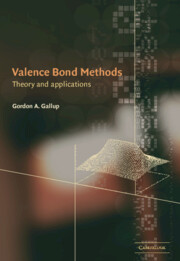Book contents
- Frontmatter
- Contents
- Preface
- List of abbreviations
- I Theory and two-electron systems
- II Examples and interpretations
- 9 Selection of structures and arrangement of bases
- 10 Four simple three-electron systems
- 11 Second row homonuclear diatomics
- 12 Second row heteronuclear diatomics
- 13 Methane, ethane and hybridization
- 14 Rings of hydrogen atoms
- 15 Aromatic compounds
- 16 Interaction of molecular fragments
- References
- Index
12 - Second row heteronuclear diatomics
Published online by Cambridge University Press: 13 August 2009
- Frontmatter
- Contents
- Preface
- List of abbreviations
- I Theory and two-electron systems
- II Examples and interpretations
- 9 Selection of structures and arrangement of bases
- 10 Four simple three-electron systems
- 11 Second row homonuclear diatomics
- 12 Second row heteronuclear diatomics
- 13 Methane, ethane and hybridization
- 14 Rings of hydrogen atoms
- 15 Aromatic compounds
- 16 Interaction of molecular fragments
- References
- Index
Summary
The consideration of isoelectronic sequences can provide considerable physical understanding of structural details. We here give details of the calculation of a series of isoelectronic diatomic molecules from the second row of the periodic table, N2, CO, BF, and BeNe. By studying this sequence we see how the competition between nuclear charges affects bonding. All of these are closed-shell singlet systems, and, at least in the cases of the first two, conventional bonding arguments say there is a triple bond between the two atoms. We expect, at most, only a Van der Waals type of bond between Be and Ne, of course. Our calculations should predict this.
The three polar molecules in the series are interesting because they all have anomalous directions to their dipole moments, i.e., the direction is different from that predicted by an elementary application of the idea of electronegativity, accepting the fact that there may be ambiguity in the definition of electronegativity for Ne. We will see how VB ideas interpret these anomalous dipole moments.
We do the calculations with a 6-31G* basis in the same way as was done in Chapter 11 and for three arrangements of STO3G bases. This will allow us both to judge the stability of the qualitative predictions to the basis and to assess the ability of the calculations to obtain quantitative answers.
We have already treated N2 in Chapter 11, but will look at it here from a somewhat different point of view.
- Type
- Chapter
- Information
- Valence Bond MethodsTheory and Applications, pp. 162 - 176Publisher: Cambridge University PressPrint publication year: 2002

